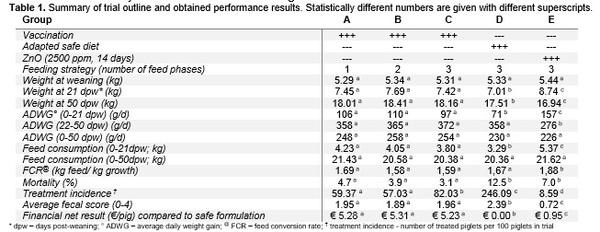Improved performance parameters following oral live non-pathogenic Escherichia coli vaccination in piglets against post-weaning diarrhea
Published: September 9, 2019
By: Frédéric Vangroenweghe / Elanco Animal Health, BU Food Animals, ANTWERPEN, Belgium.
Introduction & objective: Post-weaning Escherichia coli diarrhea (PWD), also called post-weaning enteric colibacillosis, in pigs remains a major cause of economic losses for the pig industry, due to either piglet death, or poor weight gain in surviving piglets [1,2]. PWD typically causes mild to severe watery diarrhea between 5 and 10 days after weaning and is primarily caused by enterotoxigenic Escherichia coli (ETEC). The most common adhesins found on ETEC from PWD in pigs are associated with fimbriae F4 (previously called K88) and F18, while the predominant enterotoxins are heat-labile toxin (LT), heat-stable toxin a (STa), and heat-stable toxin b (STb [3,4,5,6]. Therapy to control PWD typically consists of antibiotic treatment, addition of therapeutic doses of zinc oxide (ZnO; >2000 ppm, 14 days) and changes in feed composition of the post-weaning diets. The objective was to compare vaccination with Coliprotec® F4 (PrevTec Microbia), to two standard therapeutic approaches, namely ZnO (2500 ppm) and diet adaptations in combination with individual antibiotic treatment. The active vaccine strain in Coliprotec® F4 is one of the components of the bivalent Coliprotec® F4F18 (PrevTec Microbia) vaccine.
Material and methods: In a commercial 600-sow farm (DanBred sows x Piétrain) with PWD caused by F4-ETEC, piglets were vaccinated at 18 days of age with Coliprotec® F4. At weaning, piglets were randomly distributed into 5 groups with different treatments (Table 1). During the 7-week post-weaning period several technical production parameters (weight, average daily weight gain, feed intake, feed conversion rate, antibiotic treatment, mortality) were recorded. Statistical differences between groups were calculated using JMP® program.
Results: A summary of the obtained results is given in Table 1.

Conclusions & discussion: This comparative study clearly shows that vaccination against PWD with Coliprotec® F4 has several advantages on technical performance parameters. The type of diet (1-, 2- or 3- phase diet) did not have a significant effect on performance parameters. Overall, vaccination with Coliprotec® F4 combined a reduction of weight loss with reasonable antibiotic use. The use of safe diet formulation is not a sustainable solution, whereas supplementation of ZnO did not result in the most optimal results throughout the entire study period. In conclusion, control of PWD through oral vaccination is a good option in order to protect piglets from the negative clinical effects of F4-ETEC infection in the post-weaning period with a clear economical gain due to improved weight gain and reduced antibiotic use.
Presented at Zero Zinc Summit 2019.
References
[1] van Beers-Schreurs et al., 1992. Veterinary Quarterly 14, 29-34.
[2] Fairbrother et al., 2005. Animal Health Research Reviews 6, 17-39.
[3] Kwon et al., 2002. The Veterinary Record 150, 35-37.
[4] Frydendahl, 2002. Veterinary Microbiology 85, 169-182.
[5] Chen et al., 2004. Veterinary Microbiology 103, 13-20.
[6] Vu Khac et al., 2006. BMC Veterinary Research 2, 10.
Related topics:
Authors:
Elanco
Recommend
Comment
Share

Would you like to discuss another topic? Create a new post to engage with experts in the community.






.jpg&w=3840&q=75)